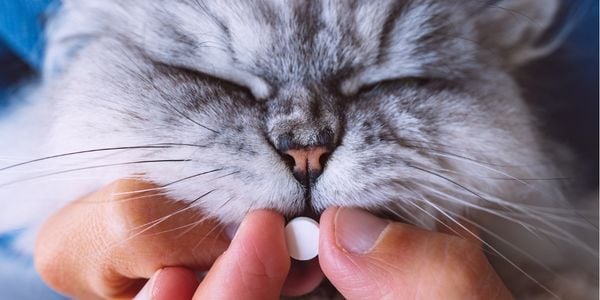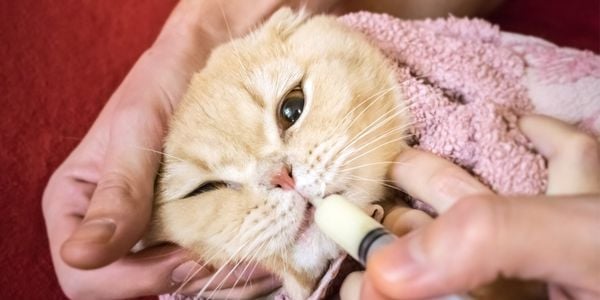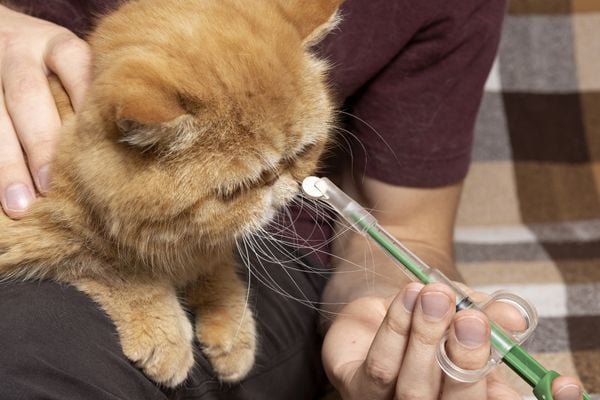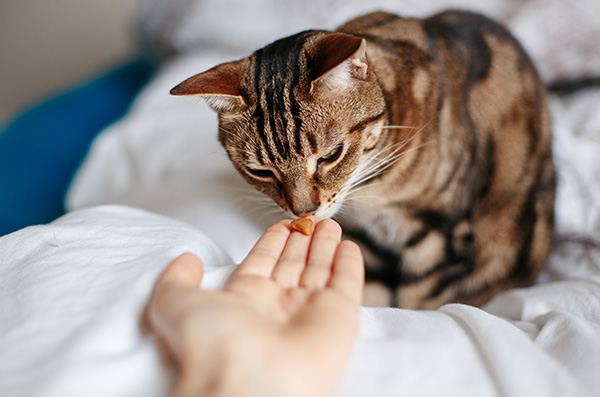
Chances are that you will have to give a pill to your cat at least once in their lifetime.
But due to all the commentaries (including this list written by a veterinarian, which is funny) about how difficult giving cats pills can be, you are likely not the least bit excited about it.
As a veterinarian, I know firsthand what a challenge it can be pilling some cats. But I can tell you, there is always a way.
What worked best for me was to give the task to my one assistant, who could pill literally any cat faster than the speed of light. If cat pilling was an Olympic sport, she would get Gold every time! All joking aside, it is critical that your cat gets the medication prescribed to them and that it is done in a way that is safe for both of you.
Here are some tips to make the task of giving your cat a pill easier.
Tips to Help You Medicate Your Cat
Put yourself in your cat’s shoes (or paws, as it were) for a moment. If someone held you down and forced you to swallow something that tasted terrible, you’d be scared and probably doing all you could to get away. That’s all your cat is doing at pill time.
They don’t know it’s for their own good. So, instead of making it a stressful experience for you and them, try some alternatives and see what works best for you both.
Giving Your Cat Choice and Control
Choice and control are essential for cats to feel safe and secure. As soon as we take away their choice to do something when they feel it’s safe, and the control to stop doing it when they feel it’s not safe, they go into defensive mode. That’s what happens when you’re prey and other animals hunt you.
Taking a few simple steps to help your cat feel they have choice and control when pilling can make a huge difference. Picking them up, moving them to the medicating area, and then holding them in place takes away their choice and control, causing them to put their guard up. Instead, use treats or toys to lure them into position.
This makes them feel like they’re choosing to be there and can leave anytime. Their guard will stay down. Giving a treat immediately before giving the meds keeps your cat in a positive place.
Give the meds quickly, follow with water, and then immediately follow with a treat to reward them.
Skip to section:
Disguising the Pill
There are several options for disguising medications. Finding the one that works best for your cat’s personality and preferences is the most important factor for success. It may take some trial and likely lots of error to see which one(s) work and also see what your cat's stomach will tolerate.
Tip 1: Try to match the timing of medication around feeding time. That way, your cat will be hungry and a bit more willing to sample a tasty treat.
Tip 2: The smellier the disguise is, the better! You want to prevent them from smelling the medication.
Tip 3: Wipe your counter clean and place the pill on it (but don’t let your cat see!). Next, wash your hands well to remove any scent of the medication. Get out your disguise wrap. Hold the wrap in one hand, then, using the other hand drop the pill in the center or at least avoid touching the outer portion of the wrap with the medication. Give the ‘surprise’ treat with the hand that DID NOT touch the pill. The main goal is to prevent any of the pill or its smell from getting on the outside of the wrap.
Tip 4: Offer one or two very small samples of the disguise before giving the one hiding the medication. Then immediately after offering the one with the pill inside, either give another small piece of what you hid the meds in or give them their regular food.
Veterinary-Recommended Pill Wrap Options for Cats
Your cat’s favorite canned food – Slightly warming it before hiding the medication helps enhance the smell but be sure it isn’t too hot before giving it.
Boiled ‘sticky’ rice meatball – Cats don’t tend to be big rice fans, but this makes a nice meatball. You can try mixing it with canned food and then making a meatball. A glutinous, sticky rice works best. Remember, don’t add any seasoning when making the rice.
For those cats that aren’t lactose intolerant, you can try any of the following. But if you are not certain whether your cat can have milk products – as many cats can't – then it's best to try other options.
- Cream cheese
- Chunks of cheese – be sure it is a soft and moldable type
- 'Squeeze' or 'easy' cheese – you know, that stuff in a can!
- Velveeta – is that even REAL cheese?!
- Butter is likely not the best bet, especially if your cat has a history of pancreatitis.
Lunchmeat – Be sure that it doesn’t contain any onions or garlic.
Liverwurst – This is a very good and smelly option, but since it is high in fat, it isn’t the best option for cats with a history of pancreatitis. Make sure to choose the plainest liverwurst you can, and make sure it doesn't have any added onion or garlic.
Canned tuna (canned in water, not oil) – TIP: Save the liquid. If hiding the pill in the tuna meatball doesn’t work, you may be able to crush it and dissolve it in the tuna juice. This Bumble Bee tuna is inexpensive but has soy, so make sure not to give it if your cat is allergic to soy. While Safe Catch tuna and Blue Harbor are more expensive, they don't have any added salt and don't contain soy.
Canned salmon (canned in water, not oil) – Tip: Save the liquid. If hiding the pill in a salmon meatball doesn’t work, you may be able to crush it and dissolve it in the salmon juice. Lafken Atlantic brand salmon is a safe choice.
Baby food – Try Gerber's turkey or chicken
WARNING: Always check ingredient lists to make sure they don't contain onion or garlic. While we choose options for you that don't, manufacturers change recipes from time to time.
Baby food salmon pouches – These pouches are convenient spout and resealable! They include beets and butternut squash, which are safe foods for cats.
Hill’s a/d – This prescription diet is a great smelly, canned food that works well to disguise pills. You will need a prescription from your veterinarian.
Pill Pockets for cats
Shapeable pill paste by Tomlyn
Vetiquinol's Nutri-Cal gel supplement
Laxatone by Tomlyn
NOTE: Keep in mind that whatever you use as a "disguiser" will likely add more calories to your cat's daily intake, so be sure to account for these extra calories in the food and treats you give them throughout the day, especially if your cat is on a weight loss program (or your cat should be).
When Disguising the Pill Won't Work
We all know that cats are super smart, have a great sense of smell, and do what it takes to protect themselves. After all, from your cat’s perspective, you’re forcing something into their mouths against their will. A little defense on their part seems like a reasonable reaction! So, despite your best efforts to hide their medications in fancy disguises, they may still not take the medication. Therefore, you need a Plan B.
Compounding Into Liquid or Gel
Liquid
Plan B involves getting or converting the medication into a liquid. Some medications come in both pill and liquid form. If you know that your cat does better with a liquid, ask your veterinarian if they can prescribe the medication that way. In some cases, this may require the medication to be specially compounded into a flavored liquid suspension (also known as a slurry) or flavored chews and treats. A reputable and licensed compounding pharmacy can help you and your veterinarian by making their necessary medications into a more palatable (yummy) or otherwise easier-to-administer form.
NOTE: A very important note regarding compounding pharmacies. Like with everything else, not all compounding pharmacies are the same. You need to speak with your veterinarian and "do your homework" to ensure that you’re using a compounding pharmacy that is reputable and licensed. The compounding pharmacy also needs to be accustomed to making medications for pets. You can find a compounding pharmacy in your area and ask questions so you can best assess them.
Transdermal Gel
Some medications can be converted into a transdermal gel by the compounding pharmacy. These are applied to a furless area such as on the ear pinna (inner ear flap).
NOTE: It is important to realize some medications are not as effective using this method as they are in their pill or liquid form. Consult with your veterinarian before having the medication prepared in this way.

What to Do If Compounding the Medication Isn't Possible?
So what do you do when the medication doesn’t come in a liquid form and can’t be compounded? In those cases, you will need to crush the pill/tablet or open the capsule and dissolve it in yummy and smelly liquid. Some options include:
- Tuna or salmon juice (see options and what to buy listed above)
- Plain unsweetened Greek yogurt slightly watered down so you can get it through a syringe. Note: If your cat is lactose intolerant, you can try unsweetened coconut yogurt. It does have a bit of a tart taste, so some cats may not like it.
- Low-sodium chicken broth – be sure it doesn’t contain onions or garlic
- Milk (don't use if your cat is lactose intolerant)
- Pet-safe gravy
- Churu squeezable treats
TIP: Be sure not to add too much liquid so you don’t have to administer a large volume of fluid. The easiest way to prevent this is to draw up the liquid you are using in a syringe first, so you know you won’t be adding too much. Add the liquid to the powder and mix until it is completely dissolved. Then add it back to the syringe.
When providing the liquid, use a syringe like this one, that doesn't have a needle and it's preferable to give it from the side of your cat's mouth, but it's always best to do what your cat is most comfortable with.
The 'Parfait' Method
You can also try the parfait method. Crush the pill. Then get your Churu or other squeezable treat and syringe. Layer some Churu, then the crushed pill, then more Churu in the syringe. Now try squeezing it out for your cat to lick. Starting and ending with the tasty treat is what gets your cat to start and continue past the medication so you can be sure they got it all. You can also try this on a dish if your cat will lick up the treat. The key is to have the good stuff on the top and bottom.
What to Do When Hiding and Liquifying the Pill Fails?
There are times when no amount of camouflage helps when trying to medicate your cat. You will still have to pill your cat in those circumstances. But before I give you tips on how to accomplish it, there are some things I want you to be aware of.
If you have ever tried to swallow a pill without taking enough water (or worse yet, no water at all), you know how uncomfortable that can feel. Besides the discomfort that can be created, some medications (i.e., doxycycline) can cause esophageal strictures (narrowing that hinders the movement of food into the stomach), choking, or other significant problems.
Make Sure to Chase the Pill
It is VERY important to ALWAYS, ALWAYS, ALWAYS follow your cat’s pills up with some food, a few treats, or a syringe full (5 or 6 ccs) of water (ask your vet for a syringe when getting your meds). You can see how this is done in our video at the end of this article.
Tips for giving water to a cat:
- While controlling your cat, place a syringe in the side of their mouth, keeping their head level.
- Slowly administer the water. Never squirt the water into their mouth or push the syringe quickly or hold the head straight up when giving water.
- Typically give 3 to 6 mls of water.
- It doesn’t take any time at all to give, and most cats tolerate it well. Adding a little flavoring, such as tuna or salmon water, makes them even more agreeable.
- Aspiration (swallowing water into their lungs) typically only occurs if water is forced in and the head position makes it hard for them to swallow.
Some pills, like doxycycline, can cause esophageal stricture (abnormal tightening of the esophagus) if your cat doesn't have an adequate chaser to move the pill into their stomach.
The other benefit of a 'chaser' is that it helps ensure that your cat has actually swallowed their medication — and that it’s not just going to be deposited somewhere behind a couch!

This Is How I Like to Give Pills to Cats – Especially When Restraint Is Needed
To be completely honest, the direct approach is my preferred method. And not because I could make veterinary nurses and technicians do it!
Because medicating or treating your cat is very important, sometimes swaddling your cat in a towel is necessary, or it adds a level of comfort for your cat. Generally, this method to me is the fastest, and I usually feel more confident that the cat has gotten all the medication.
There is a little preparation needed before you get started. Being prepared makes the whole process easier on your cat and you.
What you will need:
A comfortable open space on the floor. Ideally, use a non-slip surface.A towel – is optional but very helpful (especially if you have no help). Pre-spraying the towel (about 20 minutes prior) with a calming spray can be helpful.
A syringe with water – about 3 to 6 mls
Treats – again optional but may be a good peace offering
A pill gun – optional but oh so helpful! This is one of the best ways to help prevent getting bitten.
TIP: Whether you use the pill gun or not, I find that coating the pill in a little bit of butter helps it come out of the gun easier and aids in swallowing.
A calm cat – Personally, I feel it is always better for cats to be calm and in a good mood. This can be accomplished by giving them a calming treat or keeping them in a room with calming pheromones for about 30 to 60 minutes prior to medicating them.
Watch the videos below (a few times) to learn the technique that will work best for you and your cat. I prefer to pill cats on the floor, especially if I am alone. I feel it is safer (no risk of falling from a high place), and I have more control (less likely to be bit or scratched).
Giving Pills Using the Cat Burrito or Swaddling Method
Step 1: Kneel on the floor, creating a V shape with your legs (your cat will be placed between your legs). Your knees will be spread apart, and your feet (toes and heels) touching. This helps your cat feel secure, they can’t back up, and it gives you extra control on the sides.
Step 2: Wrap your cat up like a burrito (see video examples below). Lay a big towel on the floor. Place your cat on it, take the sides, and wrap them over your cat's back, ensuring to secure the front and back legs so they can’t get them out. Place your ‘kitty burrito’ between your legs with their head facing away from you.
Step 3: If not using a pill gun, place the medication between your thumb and index finger of your dominant hand. If using one, the pill gun will also be held in your dominant hand.
Step 4: With your other hand, carefully and gently grasp the top of your cat’s head and put your thumb on the one side of the upper jaw and your fingers on the other. Slowly tilt your cat’s head back so that their nose points up to the ceiling. This will cause their lower jaw to open a little.
Step 5: While holding the pill between your thumb and index finger, use your other fingers to gently open your cat’s mouth (a light pressure on the front teeth) a little further.
Step 6: Quickly place the pill on the back one-third of the tongue (behind the hump). The goal is to stimulate their automatic swallowing reflex. Close their mouth and gently hold it in the normal position for a few seconds. You can gently stroke their throat or blow on their face at their nose to help the swallow.
Step 6b: If you are using a pill gun, place it behind the canine tooth, into the mouth toward the back of the throat, trying to get to the back one-third of their tongue. Be careful not to jab it or advance it too far and cause trauma to the throat. Hit the plunger to advance the pill.
NOTE: Be sure to test that the plunger is working properly before starting.
Step 7: Be sure to follow with 5 to 6 cc’s of water in a syringe. Administer the water slowly, so you don’t cause your cat to choke or gag.
Step 8: Be sure to give a treat and lots of verbal praise!!
You have successfully pilled your cat!
See our video for the step-by-step process. However, this kitty doesn't need to be restrained.
Cat Bites
Another part of pilling cats that is important to be aware of is the severity of the infection you can get should your cat ever bite or scratch you in the process. Such injuries should always be attended to right away. Read more on the instructions to care for your wound should your cat bite you. And you should visit your physician or an urgent care facility immediately if it is a deep puncture.
I myself had to go to the ER for IV antibiotics following a cat bite several years back. Trust me, take all cat bites and scratches very seriously. Read more on how to care for a cat scratch.
Desensitization Tip
Cats pick up on cues. If medicating is stressful, they’ll learn what you do just before it happens so they can "get out of dodge."
Maybe you open the medicine drawer or walk into the bathroom after dinner and that sends your cat running. So, do a little work to desensitize them and change those negative associations. Do those things when you aren’t giving meds and make good things happen for your cat at the same time. Show them they don’t have to expect the worst. Sometimes they get meds (but hopefully after using some tips in this article, it will be a more positive experience.) And other times they just get great stuff. So, no need to run when you approach them at pill time.
The most important thing to do when it comes time to medicating your cat is to be calm and patient. You got this!




